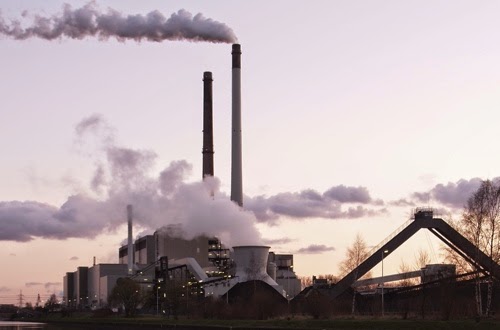Beyond Coal
Author: Geoffrey J. Janke
Contact: gjanke@pdx.edu
Coal power plants produce 44% of the power in the US. This represents the largest source for power and also represents the largest source of air pollution from power generating sources in the US. Pollutants from coal power plants include: Mercury, causing neurological damage. Metals, such as arsenic, chromium, and nickel. Causing cancer. Acid gasses, causing lung damage, contributing to asthma, bronchitis and other respiratory lung diseases. Particles, contributing to premature death and lung disease. CO2 emissions, contributing to global warming.
Most all of these pollutants are in a particulate form and CO2 is in a gaseous state. The particulates are inhaled and contribute to chronic health conditions such as cancer or chronic respiratory diseases.
CO2 is a the leading contributor to global warming and coal plants are one of the top producers of CO2 in the US. Electricity production is estimated to produce 33% of US CO2 emissions. Knowing that electricity production produces 33% of US CO2 and that coal power produces 44% of all power produced in the US, one can begin to understand why coal power plants are a large contributor to air pollution and CO2 emissions. Even though energy producers are seeking cleaner ways of producing energy a cleaner energy production method that produces as much power as a coal plant is far off.
Coal is available and relatively easy to extract from the earth. Coal is also transportable in a solid state and is much easier to transport then other fossil fuels. The regular availability of coal contributes to the issue of finding alternative sources of power production. Until coal is no longer available, or the burning of hydrocarbons becomes too toxic to live with. It is reasonable to assume that humanity will continue to use coal as its primary source of power. It’s too easy not to.
Deriving the largest portion of our energy from hydrocarbon rich sources such as coal has created the largest environmental impacts on our earth. This is the case regardless of country or specific fuel source. Until more diverse fuel sources are widely adopted we will continue down an environmental road that ultimately we will not be able to return from. This is a call for biodiversity. Seek out new and alternative fuel sources.
Contact: gjanke@pdx.edu
Sources:
Union of Concerned Scientists. (n.d). Coal vs. Wind. Retrieved from: http://www.ucsusa.org/clean_energy/coalvswind/c01.html
United States Environmental Protection Agency. (2012). Reducing Air Pollution from Power Plants. Retrieved from: http://www.epa.gov/powerplants/
United States Environmental Protection Agency. (2014). Overview of Greenhouse Gases. Retrieved from: http://www.epa.gov/climatechange/ghgemissions/gases/co2.html
Author: Geoffrey J. Janke
Contact: gjanke@pdx.edu
Coal power plants produce 44% of the power in the US. This represents the largest source for power and also represents the largest source of air pollution from power generating sources in the US. Pollutants from coal power plants include: Mercury, causing neurological damage. Metals, such as arsenic, chromium, and nickel. Causing cancer. Acid gasses, causing lung damage, contributing to asthma, bronchitis and other respiratory lung diseases. Particles, contributing to premature death and lung disease. CO2 emissions, contributing to global warming.
Most all of these pollutants are in a particulate form and CO2 is in a gaseous state. The particulates are inhaled and contribute to chronic health conditions such as cancer or chronic respiratory diseases.
CO2 is a the leading contributor to global warming and coal plants are one of the top producers of CO2 in the US. Electricity production is estimated to produce 33% of US CO2 emissions. Knowing that electricity production produces 33% of US CO2 and that coal power produces 44% of all power produced in the US, one can begin to understand why coal power plants are a large contributor to air pollution and CO2 emissions. Even though energy producers are seeking cleaner ways of producing energy a cleaner energy production method that produces as much power as a coal plant is far off.
Coal is available and relatively easy to extract from the earth. Coal is also transportable in a solid state and is much easier to transport then other fossil fuels. The regular availability of coal contributes to the issue of finding alternative sources of power production. Until coal is no longer available, or the burning of hydrocarbons becomes too toxic to live with. It is reasonable to assume that humanity will continue to use coal as its primary source of power. It’s too easy not to.
Deriving the largest portion of our energy from hydrocarbon rich sources such as coal has created the largest environmental impacts on our earth. This is the case regardless of country or specific fuel source. Until more diverse fuel sources are widely adopted we will continue down an environmental road that ultimately we will not be able to return from. This is a call for biodiversity. Seek out new and alternative fuel sources.
Contact: gjanke@pdx.edu
Sources:
Union of Concerned Scientists. (n.d). Coal vs. Wind. Retrieved from: http://www.ucsusa.org/clean_energy/coalvswind/c01.html
United States Environmental Protection Agency. (2012). Reducing Air Pollution from Power Plants. Retrieved from: http://www.epa.gov/powerplants/
United States Environmental Protection Agency. (2014). Overview of Greenhouse Gases. Retrieved from: http://www.epa.gov/climatechange/ghgemissions/gases/co2.html


No comments:
Post a Comment